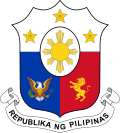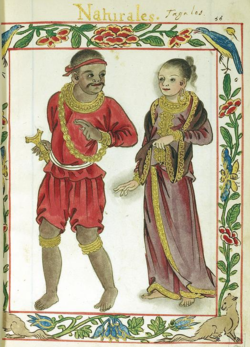Colonial period
Very little archaeological work was carried out in the Philippines during the Spanish colonial period, even though the Spaniards were interested in the people of the islands from an ethnographic and linguistic perspective. Explorers such as Fedor Jagor, Joseph Montano and Paul Ray, and Jose Rizal, occasionally reported visiting sites, but the only detailed investigation was carried out by French archaeologist Alfred Marche in 1881. Commissioned by the French government, Marche conducted systematic surveys of burial caves on two islands, accumulating a large collection of antiquities which is now held in the Musée de l'Homme in Paris. [1]
The most influential early figure in the archaeology of the Philippines was American anthropologist H. Otley Beyer. Spain ceded the Philippines to the United States in 1898, and the American colonial administration actively encouraged the anthropological study of the archipelago. Beyer was therefore invited to establish the University of the Philippines' anthropology department in 1914.
Early surveys and collections were carried out in the 1920s by Beyer, Dean C. Worcester, and Carl Guthe. Various private collectors and amateur archaeologists also accumulated significant amounts of material, but Beyer lamented that "none of this work was very scientifically done". [1]
The first major archaeological project in the Philippines was the Rizal-Bulacan Archaeological Survey (1926–1930), prompted by the discovery of finds during the construction of the Novaliches Dam in Rizal Province. Beyer opened substantial excavations in the area of the dam, employing up to seventy workers a day for six months. He also conducted a five-year survey of the surrounding area, cataloguing 120 sites and nearly 500,000 artefacts. In 1932, Beyer assisted F. G. Roth in beginning a second major project, the Batangas Archaeological Survey, which involved surveys and excavation in the Cuenca region. He also collected material from a number of localities around the islands throughout the 1930s and early 1940s. [1]
American colonial archaeology in the Philippines came to an end in 1941 when the islands were occupied by the Japanese. Beyer was interned by the occupying forces, although he was allowed to continue his work at the university. During this time he compiled two synoptic papers, 'Outline review of Philippine archaeology by islands and provinces' (1947) and Philippine and East Asian Archaeology (1948), which laid the foundation for subsequent Philippine archaeology. [1]
Post-independence
The Philippines gained independence from the United States in the 1946, but Beyer continued at his post at the University of Philippines until 1954. [1] In 1949, he was joined by Wilhelm Solheim, who was known in the Philippines for finding various pottery at different archaeological sites. In the 1960s, Robert B. Fox did archaeological work in the Philippines and is most famous for his research in the Tabon Caves. [2] In 1965, Fox had found a pot from the late Neolithic Period called the Yawning Jarlet at his time at the Tabon Caves. [3]
Alfredo E. Evangelista was a student of Beyer, Solheim and Fox and had instantly fallen in love with archaeology. In 1956, worked with Robert Fox excavating the Bato Caves in the Sorsogon Province and later on they would excavate along the coast of Cagraray and Bikol.
One of Evangelista's famous discovery in the Philippines was the excavation in 1957 of a Neolithic jar burial site in Nueva Ecija in Luzon. In 1960 he began to work with Robert Fox and Ray Santiago for the National Museum of the Philippines. [4] From the 1970s to early 1990s, Evangelista then began to work at the University of the Philippines in Quezon City and again later at the National Museum of the Philippines in Manila. [2]
In 1960, Alfredo Evangelista and F. Landa Jocano worked together and discovered the Oton death mask in San Antonio, Oton, Iloilo. Like Evangelista, Jocano he worked at the National Museum of the Philippines as well as the University of the Philippines. Inspired by Fox and Beyer, Jocano brought New World terminology by using previous data to the prehistory of the Philippines.
After Evangelista retired from the National Museum of the Philippines in 1992 Jesus T. Peralta became the Director III. Prior to becoming Director III, he was part of the Archaeology Division at the National Museum of the Philippines in 1988. [2]
Karl L. Hutterer, who studied under Solheim, became an influence to Philippine archaeology. Hutterer taught students the socioeconomic and political complexity of doing research in the field of archaeology. [2] When showing the socioeconomic processes to students, he focused on showing the diversity with the various cultures around areas. An artifact that Hutterer has examined in a geometric stone tools. [5]
In the late 1970s, William A. Longacre went to northern Luzon to do research on enthoarchaeology in the Kallinga region. He later furthered his research in southern Luzon, studying how earthenware potteries were made. An artifact that Longacre help discover and date was the Calatagan Pot with inscription. [2] In 1992, he contributed dating the pot with an accelerated mass spectroscopy, but failed to gather sufficient data. [6] He later suggested using a different form of dating C-14 technique to get an accurate date of the inscription. [2]
Before the 1980s, archaeology in the Philippines focused more on culture and history. The main way that archaeologists studied archaeology was using an inductive approach. When searching for artifacts the National Museum focused on collecting prehistoric remains. [2]







